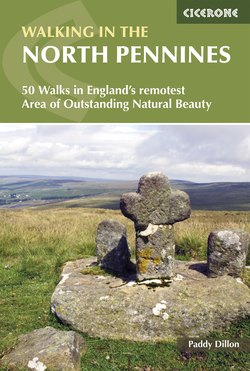Читать книгу Walking in the North Pennines - Paddy Dillon - Страница 12
На сайте Литреса книга снята с продажи.
ОглавлениеWALK 2
Hallbankgate and Cold Fell
| Start/Finish | Hallbankgate (NY 580 596) |
| Distance | 14.5km (9 miles) |
| Terrain | Tracks and paths on lower ground, but rugged, boggy moorland on higher ground. |
| Maps | OS Landranger 86. Explorer OL43 |
| Refreshments | Pub in Hallbankgate. |
| Transport | Occasional buses serve Hallbankgate from Carlisle, Brampton and Alston. |
Cold Fell is the last big, broad, boggy moorland hump at the northern end of the North Pennines. Cold by name and cold by nature, it can feature snowy slopes long after the nearby plains have thawed. The easiest access is from the village of Hallbankgate, if arriving by bus, while motorists can use an RSPB car park on the road to Howgill.
There is a pleasant grassy path at first, but rugged boggy slopes later. In case of mist, handy post-and-wire fences can be followed across the broad and open higher slopes.
Start at Hallbankgate, where facilities are limited to the food, drink and accommodation offered by the Belted Will pub, and the Co-op store. Buses are infrequent, so if relying on them, be sure to check the rather limited timetable. There is an even less frequent bus that runs a little further to a turning space on the road signposted for the RSPB Geltsdale reserve. Continue along this road and pass Clesketts to reach the RSPB Geltsdale car park. Motorists parking here can save almost 3km (2 miles) of road-walking from the day’s total.
The information office for the RSPB Geltsdale reserve is off-route beside Tindale Tarn, but the RSPB has an interest in Cold Fell and much of the surrounding land. Pick up a leaflet from the dispenser at the car park, or if information is required in advance of a visit, tel 016977 46717 or see www.rspb.org.uk. The reserve is centred on Tindale Tarn, which attracts a variety of wading birds, and includes a large organic farm at Stagsike, with flower-rich hay meadows. Nearby Bruthwaite New Wood features a mixed habitat suitable for black grouse. On the higher moors, look out for red grouse, curlew, golden plover and lapwing.
Follow a track straight ahead from the car park, passing a cottage at Tortie to approach old colliery cottages at Howgill. Note the little heaps of colliery spoil dotted around this area, marking the position of coal seams.
Turn left through a gate, then right as signposted for the Woodland Trail, and right again for the Bruthwaite Viewpoint. Small areas have been planted with saplings to create diverse habitats for birds.
A grassy path climbs past the Bruthwaite Viewpoint and runs further uphill to cross a stile over a fence. At this point, the path becomes vague, and while the broad slopes of Cold Fell rise to the right, it is actually worth drifting left uphill to reach a tall, columnar cairn on top of a rash of boulders at 547m (1795ft) on Tindale Fell.
Face the broad moorland hump of Cold Fell and head towards it, crossing a broad and boggy depression where cloudberry is abundant among the heather and grass. When climbing, drift gradually to the left, partly to avoid messy areas of peat hags and groughs, but also to reach a post-and-wire fence. Turn right to follow the fence uphill and it reaches a junction with another fence. Cross a stile to reach the top of Cold Fell at 621m (2037ft).
A bouldery burial cairn at the summit of Cold Fell, no doubt the resting place of a chieftain of note, is crowned by a trig point and other stone structures. In very clear weather some of the highest hills in southern Scotland can be discerned, while the Cheviot Hills rise beyond the bristly rug of Keilder Forest. Closer to hand is the Whin Sill, carrying Hadrian’s Wall from coast to coast. Criffel lies across the Solway Firth, with Carlisle closer to hand. Looking across the Vale of Eden, the Lake District presents rank after rank of fine fells. Cross Fell, the highest of the North Pennines, lies roughly south.
For the descent, it is best to cross back over the stile then turn left to follow the fence away from the summit. Gradients are gentle and enough people have trodden the rugged moorland to even out some of the tussocks. Keep right when a junction of fences is reached. Later, there is a steep descent on the slopes of Brown Fell, where saplings have been planted among the heather.
Turn right at the foot of the slope, following what appears to be an overgrown track. The walking becomes easier later, and the track is actually the remains of an old colliery railway. It is famous for being the last railway that was worked by Stephenson’s Rocket. Colliery spoil heaps abound, and eventually a gate gives access to the old colliery cottages back at Howgill.
All that remains is to walk back along the access track to the RSPB Geltsdale car park, if you arrived by car, or continue back along the road to Hallbankgate, if you arrived by bus.
Old terraced houses at the start of the walk in the little village of Hallbankgate
